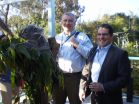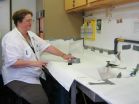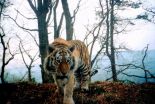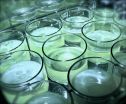(Press-News.org) Eight percent of your genome derives from retroviruses that inserted themselves into human sex cells millions of years ago. Right now the koala retrovirus (KoRV) is invading koala genomes, a process that can help us understand our own viral lineage and make decisions about managing this vulnerable species.
In a recent study scientists from the University of Illinois discovered that 39 different KoRVs in a koala's genome were all endogenous, which means passed down to the koala from one parent or the other; one of the KoRVs was found in both parents.
Koalas are the only known organisms where a retrovirus is transitioning from exogenous to endogenous. An exogenous retrovirus infects a host, inserts its genetic information into the cell's DNA, and uses the host cell's machinery to manufacture more viruses. When an exogenous retrovirus infects an egg or sperm cell and the viral genetic information is then passed down to the host's offspring, the virus becomes an endogenous retrovirus (ERV).
Like humans, koalas have evolutionary defenses against endogenization.
"During the early stages of endogenization, there are huge numbers of retroviruses. KoRVs are present all across koalas' genomes, with many thousands or tens of thousands of KoRVs in the population," said Alfred Roca, a Professor of Animal Sciences and member of the Institute for Genomic Biology at the University of Illinois at Urbana-Champaign. "Over time most of them will disappear because these copies of the virus may be present in as few as one individual chromosome. If that one individual happens to not reproduce, or if it reproduces and the other chromosome is passed down, then that ERV will disappear."
In order to end up with 100 ERVs in an organism, the species may have to start with 10,000 ERVs in its ancestors, Roca said. It takes retroviruses, like KoRV, many thousands of years to become a fixed part of the koala genome, like the eight percent of retroviral DNA that all humans share.
The ERVs that are successfully passed down are protected by the koala's DNA repair mechanisms so that their rate of mutation is extremely low. Based on the dearth of mutations in the endogenous koala retroviruses, Roca's team was able to estimate that the KoRVs integrated into the host germ line less than 50,000 years ago. "This is quite recent compared with other ERVs that are millions of years old and have accumulated mutations," said first author Yasuko Ishida, a research specialist in Roca's lab.
In koalas, KoRV has been linked to leukemia, lymphoma, and immune suppression, which can lead to increased susceptibility to chlamydia.
"It seems likely that for thousands of years since this virus integrated, the koala host has suffered fitness effects," Roca said. "It is possible that across species, when a host lineage has been invaded by ERVs, it had to go through this process of adaptation between host and virus, which is a very sad finding. It may be a very long, slow, painful process for the host species, one which human ancestors have gone through and overcome many times in the distant past."
In mammals, retroviral DNA is associated with placental development and has been found to protect hosts from harmful exogenous retroviruses.
"But once retroviruses become part of the host, they begin to help the host because that is how they survive," Roca said. "They will be better off if they evolve to protect the host. Over time, the detrimental effects go down and the beneficial effects go up."
In the 1900s, koalas were extensively hunted for their fur. In an effort to preserve koalas, a few individuals were moved to an island off the coast of Australia. Years later, the inbred island population was reintroduced to southern Australia. Today some of the southern koalas remain uninfected while almost all northern koalas have dozens of KoRVs in their genomes.
"Which is the lesser of two evils?" Roca said. "Do you try to conserve genetic diversity, which is present in the northern populations along with the retrovirus or do you conserve southern populations that don't have the retrovirus but are horribly inbred?"
INFORMATION:
Roca's research team included research specialist Yasuko Ishida, graduate student Kai Zhao, and scientific collaborator Alex Greenwood of the Leibnitz Institute in Berlin. Their work was supported by the National Institute of General Medical Sciences. The San Diego Zoo, Columbus Zoo, San Francisco Zoo, and Riverbanks Zoo provided the koala samples.
The paper, published in the journal Molecular Biology and Evolution, is available at http://bit.ly/1xcVaQZ.
It's a difficult career transition that can lead to more professional frustration and shorter tenure on the job for many of the newest generation of veterans employed with the U.S. Department of Veterans Affairs (VA) compared to their non-veteran co-workers.
New research from the University of Cincinnati is helping VA analyze the process of reintegrating veterans into civilian careers and evaluate methods for easing that transition. That's good news for all veterans as the nation prepares to observe Veterans Day on Nov. 11.
"This period of time within our labor force ...
The "food" sources that support Florida red tides are more diverse and complex than previously realized, according to five years' worth of research on red tide and nutrients published recently as an entire special edition of the scientific journal Harmful Algae.
The multi-partner project was funded by the National Oceanic and Atmospheric Administration's ECOHAB program* (described below) and included 14 research papers from seven institutions.
The research team studied four red tide blooms caused by the harmful algae species Karenia brevis in 2001, '07, '08 and '09, ...
Our genetic makeup influences whether we are fat or thin by shaping which types of microbes thrive in our body, according to a Cornell-led study published today in the journal Cell.
By studying pairs of twins, researchers identified the Christensenellaceae bacterial family, which is highly heritable and more common in lean individuals. Moreover, a member of this class of bacteria, Christensenellaceae minuta, protected against weight gain when transplanted into mice.
The findings pave the way for personalized probiotic therapies that are optimized to reduce the risk ...
Along with the pressures of habitat loss, poaching and depletion of prey species, a new threat to tiger populations in the wild has surfaced in the form of disease, specifically, canine distemper virus (CDV). According to a new study from the Wildlife Conservation Society (WCS) and its partners, CDV has the potential to be a significant driver in pushing the animals toward extinction.
While CDV has recently been shown to lead to the deaths of individual tigers, its long-term impacts on tiger populations had never before been studied.
The authors evaluated these impacts ...
NEW YORK, NY (November 6, 2014) --The most in-dept survey of its kind found that arm pain is common among supposedly healthy young baseball players and nearly half have been encouraged to keep playing despite arm pain. The findings suggest that more detailed and individualized screening is needed to prevent overuse injury in young ballplayers. The study, led by Columbia University Medical Center (CUMC) researchers, was published this week in the online edition of the American Journal of Sports Medicine.
"Both nationally and internationally, we're witnessing a troubling ...
In a paper published by PLOS ONE, researchers concluded that a national strategy must be implemented in order to compensate for environmental damage caused by development projects in Africa.
Studying these issues and other serious ethical concerns, the research discovered that current offset programs - which are planned and designed on a project-by-project basis - fail to take into account the cumulative impacts of various conservations projects taking place in the same country or region.
The scientists from the universities of California, Stirling and Kent alongside ...
This news release is available in German.
All multicellular creatures are descended from single-celled organisms. The leap from unicellularity to multicellularity is possible only if the originally independent cells collaborate. So-called cheating cells that exploit the cooperation of others are considered a major obstacle. Scientists at the Max Planck Institute for Evolutionary Biology in Plön, Germany, together with researchers from New Zealand and the USA, have observed in real time the evolution of simple self-reproducing groups of cells from previously ...
ANN ARBOR, Mich. -- Teens and young adults who get seriously injured in an assault are nearly twice as likely as their peers to end up back in the emergency room for a violent injury within the next two years, a new University of Michigan Injury Center study finds.
The researchers call this repeating pattern of violent injury a reoccurring disease, but their landmark study also suggests potentially powerful opportunities to intervene in ways that could stop the cycle.
The first six months after a young person seeks care for a violence-related injury is an especially ...
New Rochelle, NY, November 6, 2014--Lower-cost 3D printers for the consumer market offer only a limited selection of plastic materials, while industrial additive manufacturing (AM) machines can print parts made of high-performance metals. The application of a novel process called Selective Inhibition Sintering (SIS) in a consumer-priced metal AM machine is described in an article in 3D Printing and Additive Manufacturing, a peer-reviewed journal from Mary Ann Liebert, Inc., publishers. The article is available free on the 3D Printing and Additive Manufacturing website until ...
Does synthetic biology hold the key to manned space exploration of Mars and the Moon? Berkeley Lab researchers have used synthetic biology to produce an inexpensive and reliable microbial-based alternative to the world's most effective anti-malaria drug, and to develop clean, green and sustainable alternatives to gasoline, diesel and jet fuels. In the future, synthetic biology could also be used to make manned space missions more practical.
"Not only does synthetic biology promise to make the travel to extraterrestrial locations more practical and bearable, it could also ...






